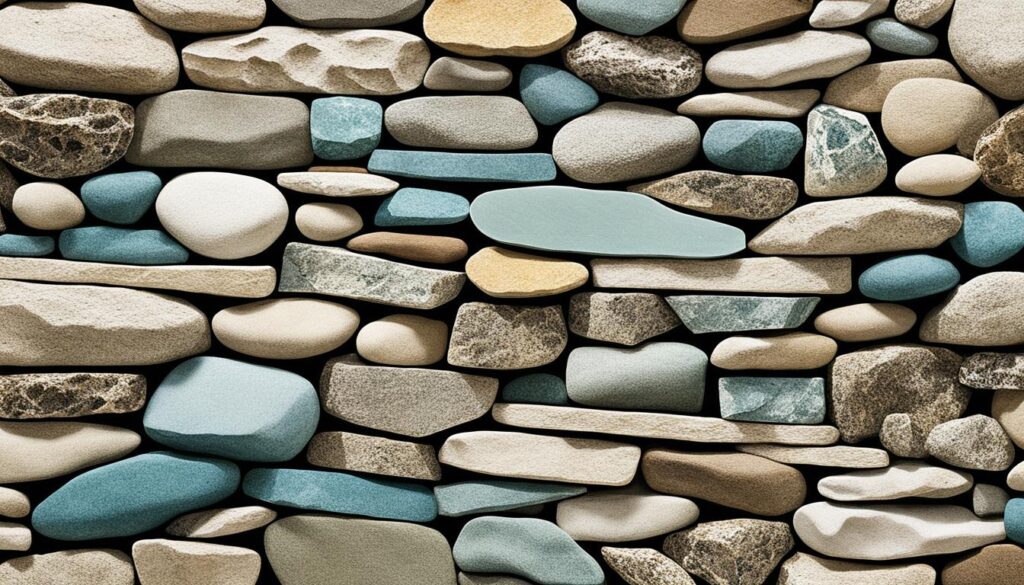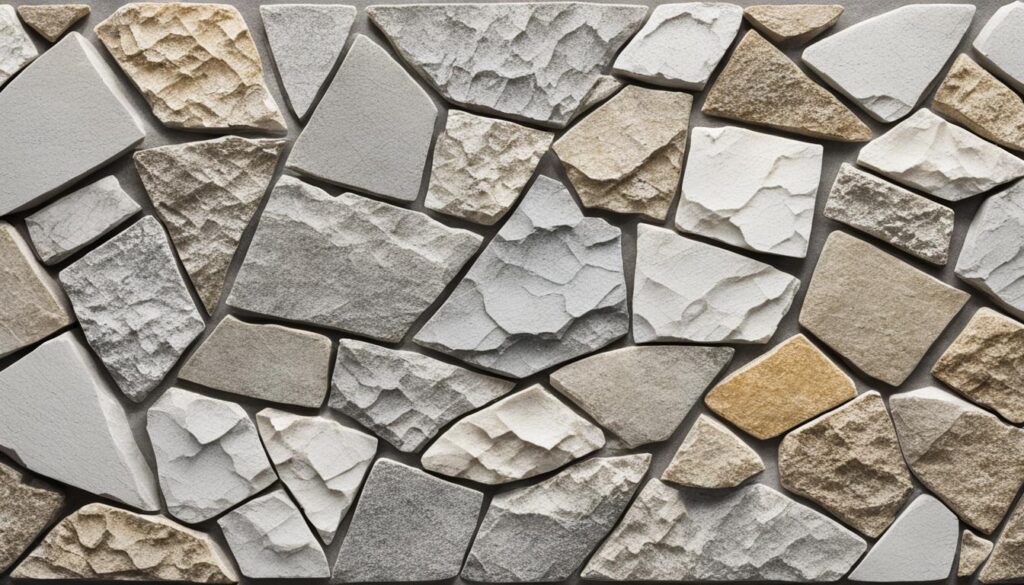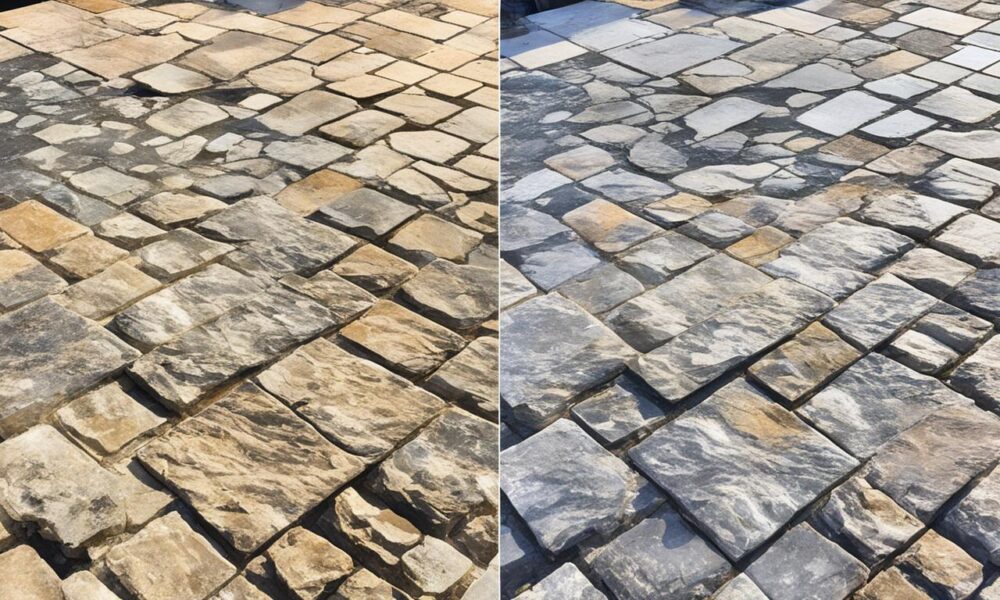Natural Stone Restoration Guide: Techniques & Tips
Natural stone surfaces like marble, granite, and limestone bring elegance and sophistication to any space. In Houston, these stones are popular for their modern style and classic beauty. But, they can lose their shine and get stained or damaged over time. That’s where natural stone restoration comes in, bringing back their stunning look.
Natural stone restoration uses various techniques to clean, seal, and restore your stone. These methods include deep cleaning, stain removal, polishing, and sealing. They help prevent damage and make your stone last longer. Experts at Modern Stone Care in Houston use advanced methods and products to fix issues like etching, discoloration, and more.
This guide covers all you need to know about natural stone restoration. We’ll talk about the different stones, preparing surfaces, and the tools and products you’ll need. By using these techniques and tips, you can keep your natural stone looking beautiful for years.
Key Takeaways
- Natural stone restoration helps revive and maintain the beauty of surfaces like marble, granite, and limestone.
- Common issues addressed by stone restoration include stains, discoloration, etching, chips, and cracks.
- Different stone types have unique properties and require specific care and maintenance techniques.
- Assessing the type of stone and extent of damage is crucial before starting restoration.
- Professional stone care specialists use advanced techniques and specialized products for optimal results.
Understanding Natural Stone and Its Characteristics
Natural stone has been a timeless choice for centuries. It’s known for its beauty, strength, and flexibility. Knowing the different types of natural stone and their features is key before starting a restoration project.
Types of Natural Stone Commonly Used in Homes and Businesses
Many types of natural stone are used in buildings, each with its own look and benefits. Some top choices include:
- Marble: Known for its elegant veining and luxurious look, marble is great for countertops, flooring, and decor.
- Granite: Granite is tough and can handle heat well. It’s perfect for kitchen counters, outdoor areas, and busy spots.
- Limestone: With soft colors and a textured look, limestone is popular for floors, walls, and outside cladding.
- Travertine: A type of limestone, travertine has unique patterns and a slightly porous surface. It works well indoors and outdoors.

Unique Properties and Benefits of Natural Stone
Natural stone has many special qualities and benefits. Some of these are:
- Durability: It’s very resistant to damage, making it a lasting choice for any project.
- Aesthetics: Every piece of natural stone is unique, adding beauty and character to spaces.
- Versatility: It can be used for many things, from floors and counters to outside walls and landscaping.
- Eco-friendliness: Being a natural material, stone is good for the environment and can be recycled.
- Increased property value: Using natural stone can make a home or business more valuable and appealing.
When picking natural stone, think about its durability, how it absorbs water, upkeep needs, cost, and how it fits with your décor. Talking to experts and seeing samples can help you make the best choice for your project.
Common Issues and Damage to Natural Stone Surfaces
Natural stone surfaces are both beautiful and tough. Yet, they can face damage over time. It’s key to know the common issues that can affect your stone. This includes stains, discoloration, cracks, chips, scratches, etching, and dulling. These problems can come from daily use, bad maintenance, or harmful substances.

Stains and Discoloration
Staining is a big issue with natural stone. Its porous nature makes it prone to stains from things like wine, coffee, or oil. These liquids can go deep into the stone, leaving marks that are hard to remove. Also, using harsh cleaners can cause discoloration by making scratches that don’t go away unless the stone is sealed.
Cracks, Chips, and Scratches
Cracks, chips, and scratches are common too. They can happen when something heavy hits the stone, damaging its look and strength. Scratches often come from daily use, like cutting on the countertop without a board. If not fixed, chips can get worse and might need professional help to fix.
Etching and Dulling
Etching is a big problem for marble or limestone countertops. It’s caused by things like citrus juice, vinegar, or some cleaners, leaving dull spots. Over time, regular wear and tear can make the stone lose its shine and look dull.
To stop or lessen natural stone damage, clean regularly with stone cleaners that are pH-balanced. Use soft tools for cleaning. Getting professional help for deep cleaning and sealing can also protect your stone from future damage, keeping it looking great for years.
| Type of Damage | Common Causes | Prevention Tips |
|---|---|---|
| Stains and Discoloration | Spills from wine, coffee, oil; aggressive cleaning | Clean spills quickly; use the right cleaners; seal the stone |
| Cracks, Chips, and Scratches | Heavy impacts; cutting directly on the surface | Use cutting boards; don’t drop heavy things |
| Etching and Dulling | Acidic substances; daily wear and tear | Avoid acidic cleaners; use coasters; clean often |
Assessing and Preparing Natural Stone for Restoration
Before starting the restoration, it’s key to check the stone carefully. This means looking at the stone’s type and how damaged it is. This helps pick the right way to fix it, making sure the treatment works well and doesn’t cause more harm.
A recent survey found that 89% of homeowners like natural stone for outdoor areas. It’s tough, unique, and easy to keep up. But even strong stones like granite and quartzite can get stained, cracked, or etched over time. A detailed check-up helps pros figure out the best way to make the stone look new again and last longer.
Identifying the Type of Stone and Extent of Damage
Experts use tools like magnifying glasses, moisture meters, and UV lights to check the stone closely. They can tell what kind of stone it is and how badly it’s damaged. Different stones, like marble or granite, react differently to problems and need specific fixes.
Some stones, like limestone or travertine, soak up water and spills easily. This makes them more likely to stain. But stones like quartzite or granite don’t absorb things as much. Knowing this helps pros pick the right cleaners and treatments.
Cleaning and Preparing the Surface for Treatment
After figuring out the stone type and damage, cleaning the stone comes next. This means getting rid of stains, dirt, and old sealants with the right cleaners. Experts say to use cleaners that are pH-neutral or made for to avoid damage.
Cleaning regularly is good for all stones, but some are more delicate. Using the wrong cleaners can hurt stones like marble or limestone. Cleaning them right and using the right products helps them look good and last longer.
| Stone Type | Porosity Level | Cleaning Frequency | Recommended Cleaning Products |
|---|---|---|---|
| Marble | High | Daily to Weekly | pH-neutral, non-abrasive cleaners |
| Granite | Low | Weekly to Monthly | Mild dish soap and water, stone-specific cleaners |
| Limestone | High | Daily to Weekly | pH-neutral, non-abrasive cleaners |
| Travertine | High | Daily to Weekly | pH-neutral, non-abrasive cleaners |
After cleaning, dry the surface well before doing any repairs or applying treatments. Getting the stone ready right is key for the restoration to work well and look great.
Essential Tools and Products for Natural Stone Restoration
Restoring natural stone surfaces requires the right tools and products for top results. From cleaning solutions and stain removers to abrasives and polishing compounds, each item is crucial. Let’s explore the key tools and products for natural stone restoration.
Cleaning Solutions and Stain Removers
The first step in restoring natural stone is cleaning the surface and removing stains. It’s important to pick the right cleaning solutions and stain removers to avoid damage. Some top products include:
- Stone-specific cleaners for the stone type
- pH-neutral cleaners that won’t harm the stone
- Specialized stain removers for tough stains like oil, grease, or rust
Abrasives and Polishing Compounds
After cleaning, address scratches, etching, or dullness with abrasives and polishing compounds. Essential tools for this include:
- Diamond pads or discs for grinding, honing, and polishing
- Polishing powders or compounds for a high gloss finish
- Variable speed grinders for precise control
Choosing the right abrasives and polishing compounds is key for the stone type and desired finish.
Sealers and Protective Treatments
The last step is applying a sealer or protective treatment to maintain the stone’s beauty and durability. Essential products for this include:
- Impregnating sealers that don’t change the stone’s look
- Topical sealers that protect the stone’s surface
- Enhancers that deepen the stone’s color and highlight its beauty
The right sealer or protective treatment depends on the stone type, location, and protection level needed.
| Tool/Product | Purpose | Recommended Usage |
|---|---|---|
| pH-neutral cleaner | Gentle cleaning without damaging the stone | Regular maintenance cleaning |
| Stain remover | Removing tough stains from the stone’s surface | As needed for specific stains |
| Diamond pads/discs | Grinding, honing, and polishing the stone | During the restoration process |
| Polishing compound | Achieving a high gloss finish | Final step in the restoration process |
| Impregnating sealer | Protecting the stone without altering its appearance | After restoration and periodically as needed |
Using the right tools, cleaning solutions, stain removers, abrasives, polishing compounds, stone sealers, and protective treatments can restore and maintain your natural stone surfaces beautifully for years.
Maintaining and Caring for Restored Natural Stone
To keep your restored natural stone looking great, follow a regular care routine. Start by wiping down surfaces with a damp cloth or mop. Use cleaners made for natural stone that are pH-neutral. Stay away from harsh chemicals that can harm the stone or its sealer.
Clean up spills right away to stop stains or etching, especially on stones like marble or limestone. This is important to keep your stone looking good.
For your stone to last, you need to do regular maintenance. This means reapplying sealer as the manufacturer suggests, usually every 1-3 years. This depends on the stone type and how much it’s used. Getting professional deep cleaning and resealing services helps keep your stone looking great and protects it from damage.
Check your stone often for signs of wear, like scratches or chips. Fixing these problems quickly stops them from getting worse. This keeps your stone in top shape.
Using coasters under glasses and mats under hot dishes helps protect your stone from etching and staining. Don’t drag heavy things across the stone to avoid scratches or chips. By following these tips, your restored stone will stay beautiful and useful for many years.



